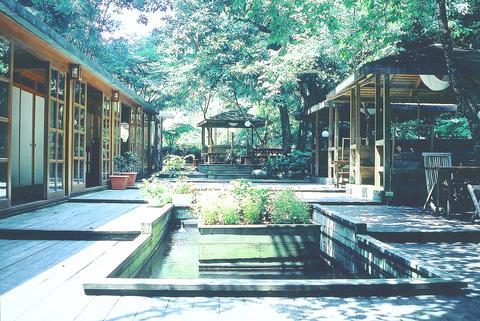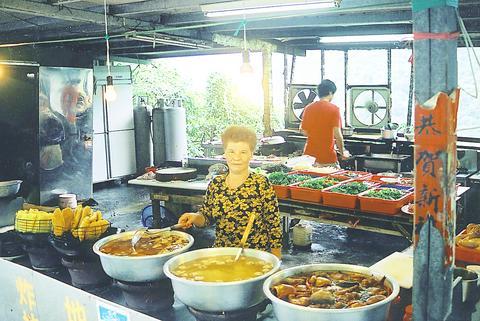If you want it all, including scenery, service, culture and tantalizing dishes, A-Ming (
It is a 20-minute drive from park headquarters. Take the Yangjin Highway toward the northeast exit of the park, past the sulfur pits and look for it on the left side of the road. Along the way there are also a number of roadside places that may be worth trying. Regrettably, the lack of an address makes A-Ming difficult to find but it probably keeps the open air sanctuary from being overrun.
With a selection of 15 crisp vegetable dishes, the house special stews, and rice and noodles cooked with a priceless secret recipe, there is little chance of dissatisfaction with your meal or of getting a check for more than NT$200 per person.

PHOTO: ADAM ULFERS, TAIPEI TIMES
At the southeastern exit of the park there are an assortment of teahouses and spas located off Jingshan Road. One place in particular is worth the winding journey that it takes to get there, which passes a collection of fascinating satellite installations, one of which belongs to Chunghwa Telecom Company, and the others are a mystery.
There is no need to check into the Silk Valley Resort to enjoy the stunning valley scenes or the variety of fresh lunches and dinners on offer at the resort, served on the elegant wooden patio for no more than NT$150 to NT$250.
But if you need to totally unwind, check in and go the whole nine-yards. To enjoy the range of services, it will set you between NT$1,000 and $5,800.

PHOTO: ADAM ULFERS, TAIPEI TIMES
Check-in is at 3pm and check-out is at 11am for couples looking for an overnight getaway. The address is: 46 Yonggong Rd, Lane 500, Taipei (

In the March 9 edition of the Taipei Times a piece by Ninon Godefroy ran with the headine “The quiet, gentle rhythm of Taiwan.” It started with the line “Taiwan is a small, humble place. There is no Eiffel Tower, no pyramids — no singular attraction that draws the world’s attention.” I laughed out loud at that. This was out of no disrespect for the author or the piece, which made some interesting analogies and good points about how both Din Tai Fung’s and Taiwan Semiconductor Manufacturing Co’s (TSMC, 台積電) meticulous attention to detail and quality are not quite up to

April 21 to April 27 Hsieh Er’s (謝娥) political fortunes were rising fast after she got out of jail and joined the Chinese Nationalist Party (KMT) in December 1945. Not only did she hold key positions in various committees, she was elected the only woman on the Taipei City Council and headed to Nanjing in 1946 as the sole Taiwanese female representative to the National Constituent Assembly. With the support of first lady Soong May-ling (宋美齡), she started the Taipei Women’s Association and Taiwan Provincial Women’s Association, where she

Chinese Nationalist Party (KMT) Chairman Eric Chu (朱立倫) hatched a bold plan to charge forward and seize the initiative when he held a protest in front of the Taipei City Prosecutors’ Office. Though risky, because illegal, its success would help tackle at least six problems facing both himself and the KMT. What he did not see coming was Taipei Mayor Chiang Wan-an (將萬安) tripping him up out of the gate. In spite of Chu being the most consequential and successful KMT chairman since the early 2010s — arguably saving the party from financial ruin and restoring its electoral viability —

It is one of the more remarkable facts of Taiwan history that it was never occupied or claimed by any of the numerous kingdoms of southern China — Han or otherwise — that lay just across the water from it. None of their brilliant ministers ever discovered that Taiwan was a “core interest” of the state whose annexation was “inevitable.” As Paul Kua notes in an excellent monograph laying out how the Portuguese gave Taiwan the name “Formosa,” the first Europeans to express an interest in occupying Taiwan were the Spanish. Tonio Andrade in his seminal work, How Taiwan Became Chinese,